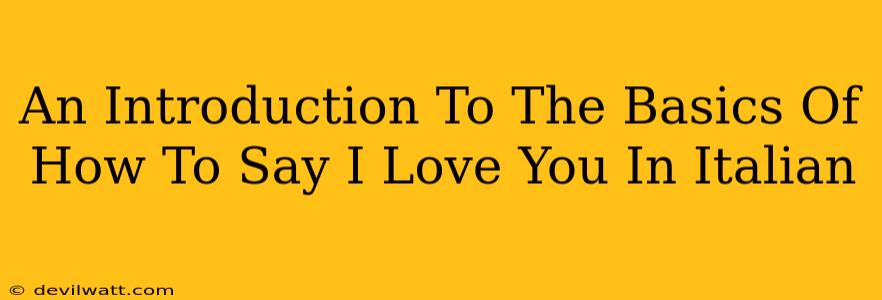Learning a new language is an exciting journey, and one of the most rewarding aspects is mastering expressions of affection. If you're planning a romantic getaway to Italy, connecting with Italian speakers, or simply expanding your linguistic horizons, knowing how to say "I love you" in Italian is a fantastic starting point. This guide will provide you with the basics, offering different nuances and contexts for this powerful phrase.
Beyond "Ti Amo": Exploring Different Ways to Say "I Love You" in Italian
While "Ti amo" is the most direct translation of "I love you," Italian, like many languages, offers a rich tapestry of ways to express love. The choice depends on the relationship, the context, and the intensity of your feelings.
Ti Amo: The Classic Declaration
Ti amo is the most common and straightforward way to say "I love you" in Italian. It's a strong declaration of romantic love and is best reserved for significant relationships. Use this phrase with someone you deeply care for. It's passionate and heartfelt.
Ti voglio bene: More Than Friendship, Less Than Love
Ti voglio bene translates literally to "I want you well," but its meaning is far richer. It signifies deep affection and care, often used in familial relationships or close friendships. It conveys a strong bond but not necessarily romantic love. Think of it as "I love you" in a familial or platonic sense.
Amo te: A More Formal Option
While functionally the same as "ti amo," amo te is a slightly more formal and less common way to express your love. The difference is subtle, but it might feel more appropriate in a formal setting or with someone you're not yet completely comfortable with.
Context is Key: When to Use Each Phrase
The beauty of the Italian language lies in its ability to express subtle differences in emotion. Understanding the context is crucial to selecting the appropriate phrase.
-
Romantic Love: Use ti amo unequivocally. This is the phrase to use for declarations of passionate romantic love.
-
Family & Close Friends: Ti voglio bene is the perfect way to express deep affection and care within these relationships.
-
Formal Settings: While less common, amo te provides a more formal alternative to expressing romantic love.
Beyond the Words: Showing Your Love in Italian
Learning how to say "I love you" is only the first step. True communication goes beyond words. Consider how your tone of voice, body language, and overall demeanor will influence the impact of your message. Genuine affection is conveyed not just through words, but through actions and overall behavior.
Expanding Your Vocabulary: Words Related to Love in Italian
To further enrich your understanding of expressing love in Italian, consider exploring related vocabulary like:
- Amore: Love (noun)
- Amato/Amata: Beloved (adjective)
- Passione: Passion
- Affetto: Affection
By learning these terms, you’ll enhance your ability to communicate the depth and complexity of your feelings.
Conclusion: Embracing the Nuances of Italian Love
Mastering the art of saying "I love you" in Italian is more than just memorizing a phrase; it's about understanding the cultural nuances and the richness of the language. By using these phrases appropriately and with genuine feeling, you can express your love authentically and connect more deeply with Italian speakers. So, go forth and spread the amore!

